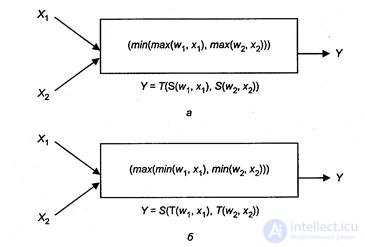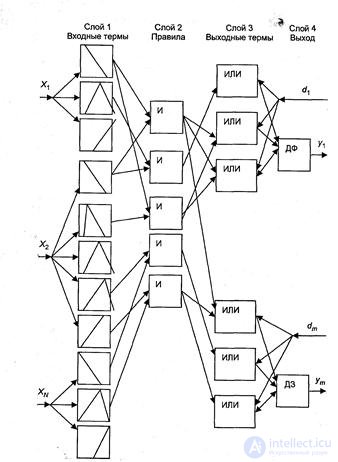Lecture
The effectiveness of the neural networks apparatus is determined by their approximating ability, and the NA are universal functional approximants. With the help of the National Assembly, it is possible to express any continuous functional dependence based on the training of the National Assembly, without preliminary analytical work on identifying the rules for the dependence of output on input. The disadvantage of neural networks is the inability to explain the output, since the values are distributed over the neurons in the form of weights. The main difficulty in applying fuzzy expert systems is the need to explicitly formulate the rules of the problem area in the form of products. In fuzzy expert systems, it is easy to construct an explanation of the result in the form of a protocol of reasoning; therefore, hybrid technologies are currently being created that combine the advantages of fuzzy systems and neural networks.
An example of a hybrid technology is the implementation of a system of fuzzy rules based on a neural network. The base of fuzzy rules for two input and one output variables has the following structure:

To implement the base of fuzzy rules, we will interpret it as a table of the definition of a certain function, i.e., the rule base can be represented by a training set: {((  ,
,  ,
,  )}. For example, {((small, large), near zero)}.
)}. For example, {((small, large), near zero)}.
In most fuzzy concepts represented by linguistic variables, their meanings are expressed using quantitative fuzzy sets:
1) NB - negative large;
2) NM - negative average;
3) NS - negative small;
4) ZE - near zero;
5) PS - positive small;
6) RM - positive average;
7) RV - positive large.
Deep integration of fuzzy systems and neural networks is associated with the development of models of neurons whose functions differ from those of a traditional neuron.

Figure 9.1 - Examples of fuzzy neurons:
a) E-neuron, b) OR neuron.
The modification of a neuron model for adaptation to fuzzy systems concerns the choice of the activation function, the implementation of the operations of addition and multiplication, since in fuzzy logic, addition is modeled by any triangular conorm (for example, max, a + b - a  b, ...), a multiplication is triangular norm (min, a • b, ...).
b, ...), a multiplication is triangular norm (min, a • b, ...).
An e-neuron is a neuron in which the multiplication of the weight w by the input x is modeled by the conorm S (w, x), and the addition by the norm T (w, x). For a two-input I-neuron, the following formula is valid:

The OR neuron is called a neuron, in which the multiplication of the weight w and the input x is modeled by the norm T (w, x), and the addition of weighted weights is the conorm S (w, y). For a two-input OR neuron, the formula is:

If we choose as T - min, and S - max, then the formula for the transformation of an OR neuron is refined as follows:

As an activation function, a radial basis function is usually used:

The fuzzy neural network (NNS) is a clear neural network of direct signal propagation, which is based on a multi-layered architecture using AND, OR neurons.
The fuzzy neural network functions in a standard way on the basis of clear real numbers. Fuzzy is only the interpretation of the results. When creating a hybrid technology, you can use neurocomputing to solve a particular problem of fuzzy expert systems, namely, setting the parameters of the membership function.
Traditionally, membership functions are formed in two ways: by the method of expert evaluation or on the basis of statistics. Hybrid technologies offer a third method: a parameterized form function (for example, a parameterized Gaussian curve) is selected as the membership function, the parameters of which are configured using neural networks. Parameter tuning can be obtained using the error back-propagation algorithm.
Consider its use for learning NNS. Let the following system of fuzzy rules is given:

Assume that a neural network is developed with n inputs and one output. How can such an NA approximate a base of fuzzy rules? Any set of fuzzy products can be considered as a nonlinear correspondence given by the definition table {(x k , y k }}, where k = 1 , ..., K is the sample line number in the training set, x is the input vector, y is the desired output value, a z - output value calculated by the neural network. If you determine the current error using the formula  , then you can apply the standard error correction algorithm, adjusting the output Z according to the following rule:
, then you can apply the standard error correction algorithm, adjusting the output Z according to the following rule:

Substituting into the rule the formula for the weighted average output of the NNS, we get:

When applying the standard error back-propagation algorithm to configure the NN output, it is necessary to change the parameters of the membership functions of the conditional parts of the rules, that is, the network training will allow you to configure them for the training set.
Consider the structure of hybrid systems (HS), solving the task of management, we select the features of the architecture and learning algorithms for each specific type of HS.
NNFLC - fuzzy controller based on NA (Neurons network fuzzy logic controller). The structure of NNFLC is shown in Fig. 9.2. The NNFLC structure is a multilayered network of direct signal propagation, with different layers performing different functions. We describe briefly the functions of the layers.
Layer 1 represents the membership functions implemented as radial basic neurons.

Layer 2 models the AND conditions of the rules.

Layer 3.

Layer 3 is an OR - a combination of rules with significant terms in consequent and performs various functions in the operating mode and in the learning mode. In the learning mode, the layer adjusts the parameters of the membership functions of the output variables. In the operating mode, forms the output destination.


Figure 9.2 - Structure of NNFLC.
The NNFLC NNFLC structure is initialized according to the principle of forming a complete matrix of rules. If a  - input variables
- input variables  - number of fuzzy marks (splits)
- number of fuzzy marks (splits)  , the original number of rules:
, the original number of rules:

Learning NNS complex architecture (with different functional layers) usually occurs in multiple stages, and at each stage different learning algorithms are used: pre-training (offline), operational (online), teacher's position, with a teacher.
The general scheme of teaching NNFNS NNS contains the following steps:
• formation of training data;
• self-organizing clustering (setting membership functions);
• competitive training (winner algorithm);
• delete rules;
• combination of rules;
• final adjustment of parameters (tuning) of membership functions using the error back-propagation algorithm.
We present the informative characteristics of the stages of learning. Setting the parameters of membership functions includes the definition of centers  and widths
and widths  for membership functions represented by form functions:
for membership functions represented by form functions:

Winner Algorithm Reveals 

Where  - monotonously decreasing level of education.
- monotonously decreasing level of education.
Width adjustment  It is carried out heuristically, for example, according to the principle of “first nearest neighbor”:
It is carried out heuristically, for example, according to the principle of “first nearest neighbor”:

Where  - overlap parameter.
- overlap parameter.
Winner Algorithm Searches Weights Matrix  , which assesses the quality of the links of the left and right parts of the rules:
, which assesses the quality of the links of the left and right parts of the rules:

Combining rules is often advisable to perform with the participation of an expert. The final configuration of the membership functions is performed using the error back-propagation algorithm for the error function.  . The chain of rules propagates an error up to layer 1 with back propagation. Thus, it can be concluded that the NNFLC architecture can be interpreted as a Takadzhi-Suzheno fuzzy inference system.
. The chain of rules propagates an error up to layer 1 with back propagation. Thus, it can be concluded that the NNFLC architecture can be interpreted as a Takadzhi-Suzheno fuzzy inference system.
Comments
To leave a comment
Intelligent Information Systems
Terms: Intelligent Information Systems